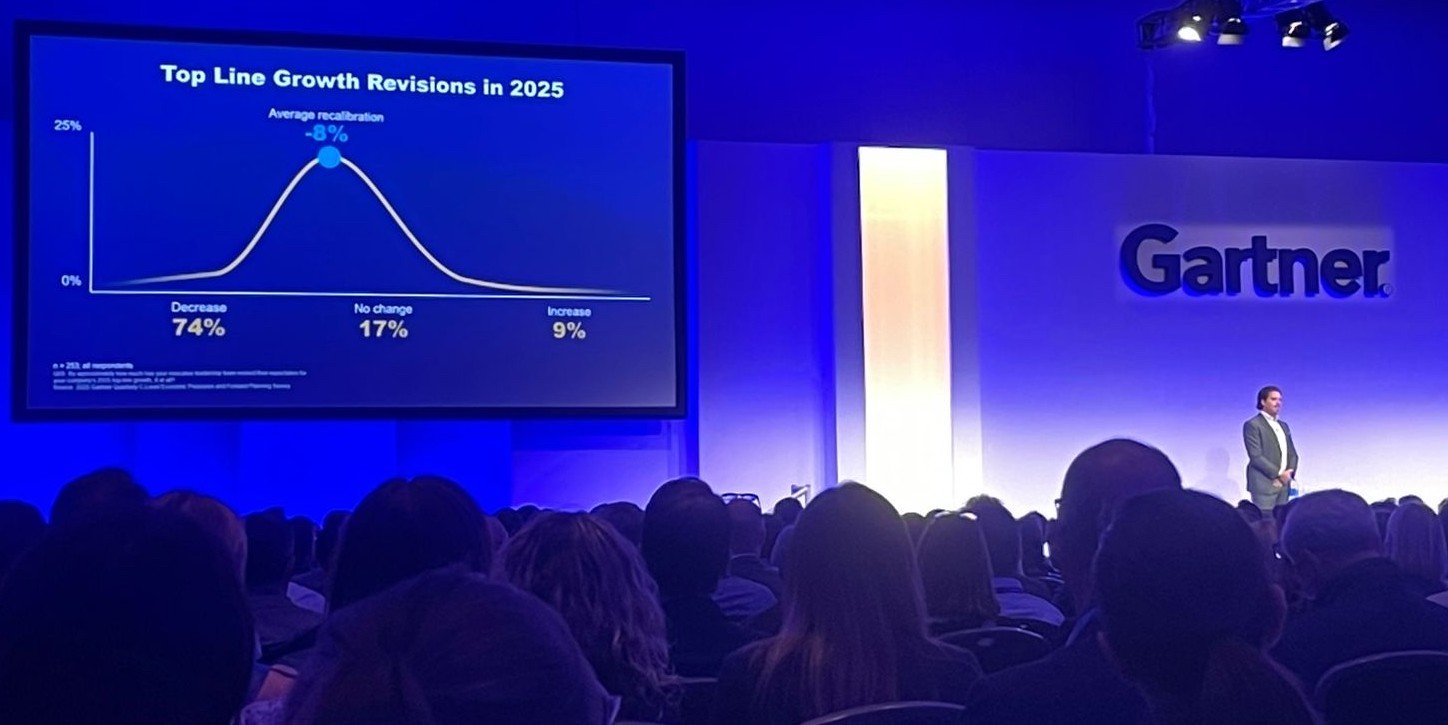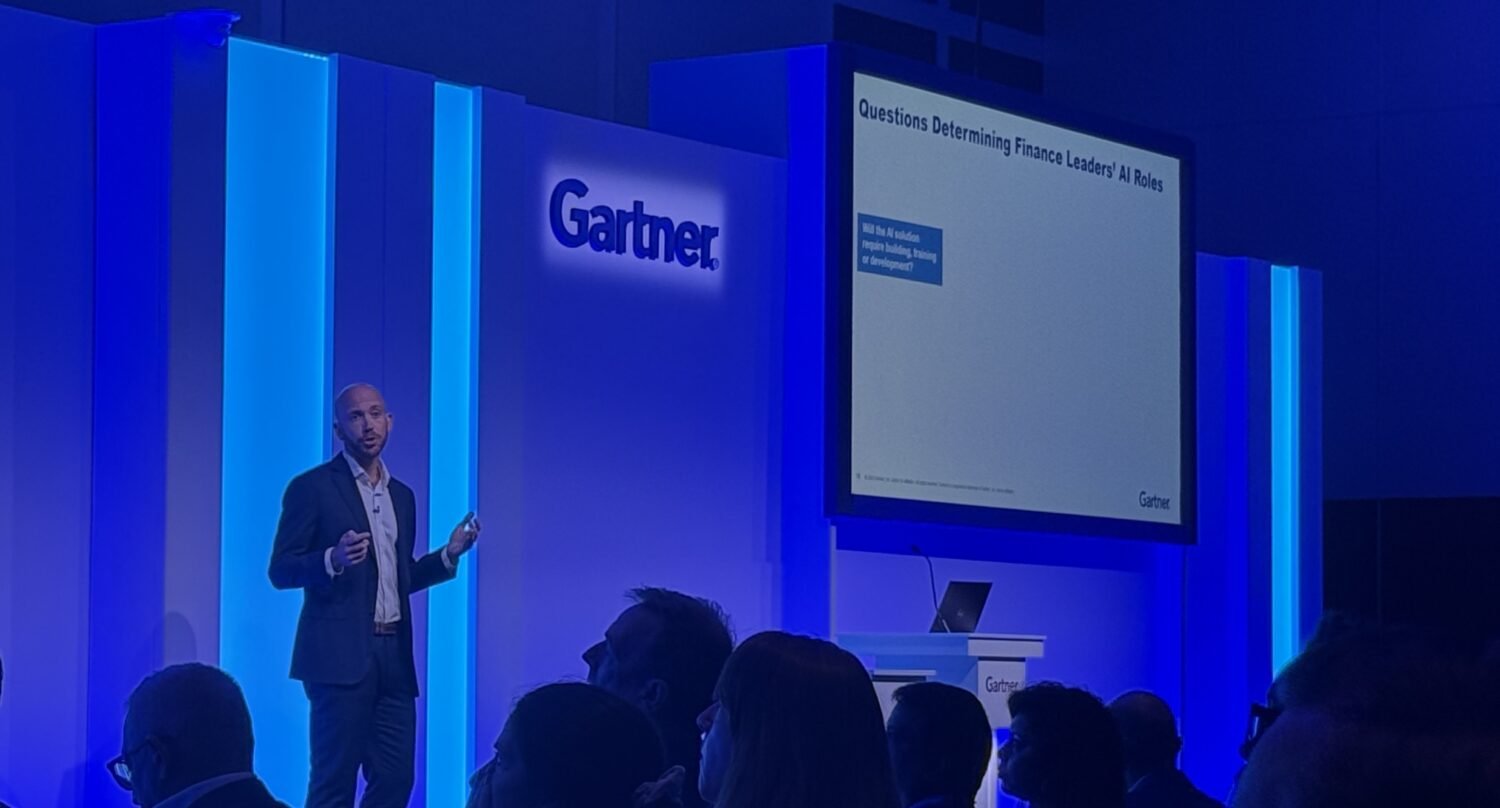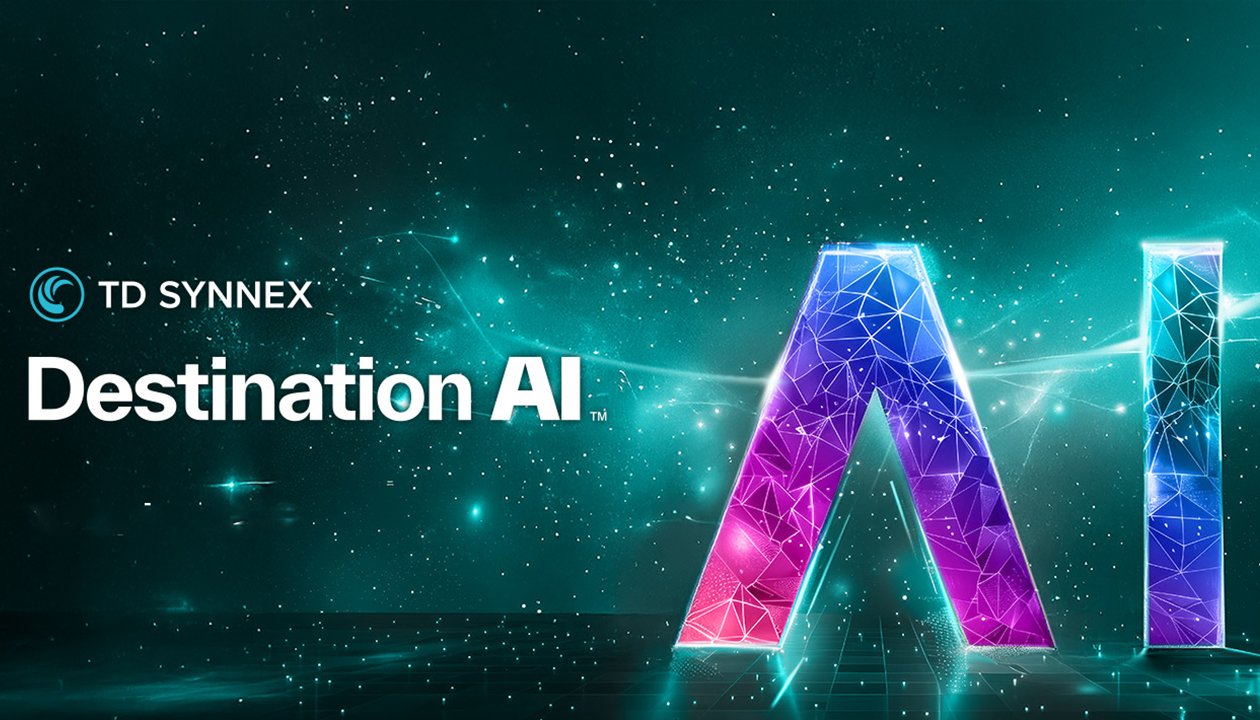The AI revolution is here, and it’s accelerating fast. Don’t get left behind. In this video, TD SYNNEX reveals its Destination AI program—your strategic guide to navigating this rapidly expanding market. Learn how to transform your business and gain a competitive edge with our all-in-one program that offers everything from expert training and certification to ongoing sales support. Join us and harness the incredible power of AI to build a future-proof business.
Tools & Platforms
AI, identity, and the next phase for finance – Insights from Gartner’s CFO Conference

The first day of the Gartner CFO & Finance Executive Conference in London was a study in contrasts. On one hand, finance leaders are grappling with uncertainty, talent shortages, and the relentless hype around artificial intelligence. On the other, they are being urged to seize the moment, to move beyond guardianship and redefine finance as a catalyst for growth.
Across keynote sessions, panels, and conversations with technology providers, the message was clear: digital projects and automation alone will not transform finance.
A new identity is required, one that balances precision with agility, and control with empowerment.
Finance Needs a New Identity
The conference opened with a challenge from Gartner analysts Mallory Bulman and Clement Christensen: finance must stop treating digital projects as a collection of tactical fixes and instead reshape its very identity.
They laid out eight forces set to define finance through 2030, from the rise of do-it-yourself technology and AI-driven decision-making to the looming crash in finance talent. Matrixed organizations, regulatory flux, and the growing importance of human connection added to the picture of a function under strain.
Against this backdrop, Gartner argued for the rise of the “catalyst CFO.” These leaders, Bulman and Christensen said, distinguish themselves by adopting four habits: reframing how they talk about finance, embracing complexity, deploying business tools rather than more headcount, and focusing on products rather than processes.
The message resonated across the day: how finance leaders describe their teams shapes how those teams are seen, and whether they are viewed as cost centers or strategic drivers.
Leadership and AI Under the Microscope
Other Gartner sessions reinforced the same themes.
Dennis Gannon, VP Analyst at Gartner, pointed to worrying data on leadership in finance: fewer than half of employees are satisfied with management at their firms, and one in four are looking to leave. Promoting technical experts without equipping them for leadership, he warned, is a recipe for disengagement and attrition. His solution: develop “connector managers” who prioritize relationships, empathy, and adaptability alongside business acumen.

Marco Steecker, Senior Director of Research at Gartner, urged CFOs to take a deliberate role in shaping AI adoption. Whether as end-user advocates, co-developers, pioneers, or enterprise champions, CFOs need to start with business objectives and then align AI solutions.
Yet Gartner data shows fewer than 40% of finance leaders are even consulted on enterprise AI projects, a gap that risks leaving finance on the sidelines of critical decisions.
And in a session on digital storytelling, Christensen reminded attendees that numbers rarely move people on their own. Wrapping data in narratives and visual context, he argued, is essential if CFOs want their insights to drive decisions. Poor communication of financial information, Gartner estimates, costs companies up to 8% of EBITDA.

Conversations with Industry Leaders
If the keynotes set the strategic tone, the conversations on the sidelines brought the operational reality into focus.
Over the course of Day One, The CFO spoke with leaders from FloQast, BlackLine, Soldo, and other providers shaping the finance technology landscape.
FloQast: AI, Change Management, and the Close
For Hugh O’Neill, Chartered Accountant at FloQast, the conference floor was dominated by two themes: AI and change management.
“There’s a lot of talk about AI, what it actually does and how to use it,” he said. “But there’s also a big people element. How do we manage the transition? How do we evolve? It’s an evolution of the profession.”
O’Neill, who previously served as a finance director, said the draw of technology is its ability to free teams from spending endless hours fixing data and reconciling numbers. “Historically, finance has been about getting the numbers right, looking at the past. Technology allows us to move beyond that—to automate the mundane tasks and focus on critical thinking and faster decision-making.”
In his own session, The AI Challenge – Reimagining the Finance Function, O’Neill spoke about the pressure to shorten the close cycle. “If you have a 10-day close, you want five. If you have five, you want two. If you have two, you want zero,” he said.

AI, he argued, can take on transactional processes and allow humans to focus on strategic problems. The challenge is clarity: defining which processes to change, what success looks like, and preparing people for new roles.
“AI creates uncertainty, but it also creates possibility,” he said. “It’s about defining what can be automated and then guiding people toward what they should do next.”
Looking ahead, O’Neill believes finance teams will need to rebalance their skills mix.
“Today, maybe 80% of roles are traditional finance and 20% are systems-focused. That’s shifting toward 50/50,” he predicted. Leaders, he said, must guide their teams through that change while celebrating wins along the way.
BlackLine: Building Trust in AI
Few providers drew a bigger crowd than BlackLine. The company’s session was so oversubscribed that some CFOs sat cross-legged on the floor to listen. The draw, according to executives Philippe Omer-Decugis and Josh May, came down to one word: trust.
“AI is on everyone’s agenda, but 95% of projects don’t deliver ROI because of immaturity, whether in change management or use cases,” Omer-Decugis said. “CFOs are being asked to orchestrate transformation across the entire organization, while also cutting costs, managing risk, and upskilling people. What they want now is simple: cut through the noise and show me the use cases that deliver value today.”
BlackLine’s answer is Verity, a new platform whose name means “truth.” The system uses ERP data to validate journal entries at the source, which in turn improves transaction matching, reconciliation, and ultimately the accuracy of financial statements. “It’s like suddenly adding a team of analysts who never get sick and never miss things,” May said.
He pointed to intercompany accounting as a prime use case. Many global firms still struggle with inefficiencies that lead to large write-offs. “If you get the inputs right and validate them with AI, you can scale without endlessly adding headcount,” May said.
Beyond the technology, Omer-Decugis highlighted a broader shift in shared service centers. “Simply adding more people in low-cost markets is no longer enough. CFOs need technology layered into these models to meet productivity expectations,” he said.
Both executives stressed that CFOs must also partner closely with CIOs as they migrate ERP systems like SAP ECC to S/4HANA. “The best CFOs I meet have a clear understanding of architecture and digital transformation,” Omer-Decugis noted.
For BlackLine, trust is the differentiator. “When we publish something, it’s a solution, not just a slide,” Omer-Decugis said. “That’s why CFOs know they can trust us.”
Soldo: From Guardian to Catalyst
At Soldo, the focus is on giving finance leaders control of decentralized spending without becoming bottlenecks. Brandon Till, Head of Business Solutions, described the company’s platform as a way to handle “all the messy spend that doesn’t fit through central processes.” Employees can access money when needed, while finance maintains oversight through cards, a platform, and an app.
For Till, the Gartner keynote’s warning against a “guardian mindset” hit home. “Nine out of ten CFOs are getting it wrong by holding back too much,” he said. “The opposite should be true, finance needs to be a catalyst, enabling teams to seize opportunities. That’s where the successful businesses of the future will come from.”
He also flagged the looming retirement cliff in accounting. “Seventy-five percent of people in accounting are at or nearing retirement age. Finance teams need to speed up transformation to fill that gap,” he said. That means investing in automation, but also building workplaces that attract young talent.
“Young professionals don’t want to join teams stuck in outdated processes,” Till said. “They want to be part of finance teams that are strategic leaders, using modern tools.”
Internally, Soldo uses AI tools across functions, from one-off design purchases to enterprise-wide LLM licenses. Externally, the platform makes it easier for teams to adopt new technologies without lengthy procurement hurdles.
Looking forward, Till sees a clear shift in the CFO’s role. “Just as you get a laptop when you start a job, you should also get a company card,” he said. “Finance should never be a bottleneck. It should enable people to do their jobs quickly and well.”
Aibidia: Transfer Pricing as a Strategic Asset
Reuben Sagar, Chief Revenue Officer, and Maria Helander, VP of Product, discussed the findings of Aibidia’s 2025 State of Transfer Pricing report. With only 14% of firms making heavy use of structured transfer pricing data, Helander argued that CFOs must reframe compliance data as a value-generating asset.
Sagar highlighted the push toward audit readiness: “Rather than reacting, companies want to have data in place to understand why decisions were made.” Both executives said regulatory uncertainty—from OECD Pillar Two to tariffs—has pushed transfer pricing firmly onto the CFO agenda.
Esker: Agentic AI and the Expanding CFO Role
Eric Bussy, Chief Marketing Officer at Esker, said CFOs need visibility and agility in a volatile world. Esker’s Agentic AI Suite, which integrates both source-to-pay and order-to-cash, is designed to minimise silos and accelerate responsiveness.
“The time of the ERP is not compatible with the time of the organisation,” Bussy said. He described the CFO’s evolving position as a “strategic connector” across the C-suite and argued that real-time transparency—delivered in hours, not days—is now a baseline expectation.
Pigment: Analyst Agents and Digital Workforces
Edouard Beaucourt, Head of EMEA at Pigment, unveiled the company’s launch of three AI-powered agents—Analyst, Planner, and Modeler—during the event. Designed to accelerate replanning and scenario modelling, the agents form what he called a “digital workforce” that augments finance teams.
“The idea that AI will replace people is a misperception,” Beaucourt said. “It’s really about augmentation.” Pigment’s customers, including Vinci, Idex, Snowflake, and Carhartt, are already using AI assistants in production, with Beaucourt stressing that the priority is selecting the right technology, targeting processes with quick returns, and cultivating adaptable early adopters.
Serrala: Intelligent Working Capital as a Growth Lever
Rami Chahine, Chief Product & Technology Officer at Serrala, said CFOs must move beyond back-office routines to treat working capital as a lever for growth. By combining receivables, payables, and treasury into a single platform, Serrala enables real-time visibility.
“There’s a misconception that AI is a silver bullet,” Chahine said. “The reality is AI only works if the data is clean, integrated, and available in real time.” Customers are already seeing up to 40% of invoices processed touchlessly, freeing teams to focus on strategy.
insightsoftware: Precision, Not Guesswork
Shameek Bhushan, Senior Vice President at insightsoftware and Co-Founder of JustPerform, underlined that finance cannot operate on estimates. “Numbers are never wrong, and responses need to be precise,” he said. While AI can automate reconciliation and other repetitive tasks, Bhushan warned that humans must remain in the loop to validate outputs.
He positioned insightsoftware as one of the broadest office-of-finance platforms, spanning reporting, consolidations, and regulatory filings. Looking ahead, he said agentic workflows—specialised digital agents trained like employees—will be the next frontier.
Anaplan: Bridging Strategy and Execution
Piers Bradley, Senior Solution Consultant at Anaplan, described the company’s mission as “decision excellence.” He said CFOs face the dual challenge of setting long-term strategies while managing day-to-day execution. Anaplan’s AI roadmap spans predictive forecasting, generative conversational tools, and emerging agentic capabilities.
“It’s about removing blind spots and ensuring planners can correct course quickly,” Bradley said. He encouraged CFOs to engage directly with the technology through workshops and executive sessions, adding: “Planning technology is now fundamental to running a successful business.”
Themes Emerging
By the close of Day One, several themes had crystallized.
First, AI is unavoidable, but its success depends on precision, governance, and the ability to translate use cases into tangible outcomes. From FloQast’s focus on closing cycles to BlackLine’s emphasis on intercompany accounting and Soldo’s work on decentralized spend, the practical applications are beginning to outweigh the hype.
Second, identity and leadership matter as much as technology. Gartner’s call for finance to reframe itself as a catalyst, combined with warnings about weak people management, underscored that transformation is not just a technical project. It is a cultural one.
Third, the talent equation is becoming urgent. Whether it is FloQast predicting a 50/50 split between finance and systems skills, or Soldo warning of a retirement cliff, CFOs are acutely aware that automation alone cannot fill the gap. Attracting and retaining talent will require modern tools, new mindsets, and better leadership.
Finally, trust remains the ultimate currency. As BlackLine executives noted, CFOs want AI they can rely on. Without trust in the numbers, no amount of dashboards or models will suffice.

Closing Note
Day One of the Gartner CFO & Finance Executive Conference underscored both the pressure and the possibility facing finance leaders. AI, identity, and transformation dominated the agenda, but the real test lies in execution—how quickly CFOs can turn theory into practice while guiding their teams through change.
Day Two promises deeper dives into future-ready operations, more on agentic AI, and further perspectives from finance leaders on the front lines of transformation.
Stay tuned..
Was this article helpful?
YesNo
Tools & Platforms
Destination AI | IT Pro
Tools & Platforms
AI, Workforce and the Shift Toward Human-Centered Innovation

Artificial intelligence has been in the headlines for years, often linked to disruption, automation and the future of work. While most of that attention has focused on the private sector, something equally significant has been unfolding within government. Quietly, and often cautiously, public agencies are exploring how AI can improve the way they serve communities, and the impact this will have on the workforce is only just beginning to take shape.
Government jobs have always been about service, often guided by mission over profit. But they’re also known for process-heavy routines, outdated software and siloed information systems. With AI tools now capable of analyzing data, drafting documents or answering repetitive inquiries, the question facing government leaders isn’t just whether to adopt AI, but how to do so in a way that enhances, rather than replaces, the human element of public service.
A common misconception is that AI in government will lead to massive job cuts. But in practice, the trend so far leans toward augmentation. That means helping people do their jobs more effectively, rather than automating them out of existence.
For example, in departments where staff are overwhelmed by paperwork — think benefits processing, licensing or permitting — AI can help flag missing information, route forms correctly or even draft routine correspondence. These tasks take up hours of staff time every week. Offloading them allows employees to focus on more complex or sensitive issues that require human judgment.
Social workers, for instance, aren’t being replaced by machines. But they might be supported by systems that identify high-risk cases or suggest resources based on prior outcomes. That kind of assistance doesn’t reduce the value of their work. It frees them up to do the work that matters most: listening, supporting and solving problems for real people.
That said, integrating AI into public workflows isn’t just about buying software or installing a tool. It touches something deeper: the culture of government work.
Public agencies tend to be cautious, operating under strict rules around fairness, accountability and transparency. Those values don’t always align neatly with how AI systems are built or how they behave. If an AI model makes a decision about who receives services or how resources are distributed, who’s accountable if it gets something wrong?
This isn’t just a technical issue, but it’s about trust. Agencies need to take the time to understand the tools they’re using, ask hard questions about bias and equity, and include a diverse range of voices in the conversation.
One way to build that trust is through transparency. When AI is used to support decisions, citizens should know how it works, what data it relies on, and what guardrails are in place. Clear communication must be visible and oversight goes a long way toward building public confidence in new technology.
Perhaps the most important piece of this puzzle is the workforce itself. If AI is going to become a fixture in government, then the people working in government need to be ready.
This doesn’t mean every employee needs to become a coder. But it does mean rethinking job roles, offering training in data literacy, and creating new career paths for roles like AI governance, digital ethics and human-centered design.
Government has a chance to lead by example here. By investing in employees, not sidelining them, public agencies can show that AI can be part of a more efficient and humane system, one that values experience and judgment while embracing new tools that improve results.
There’s no single road map for what AI in government should look like. Different agencies have different needs, and not every problem can or should be solved with technology. But the direction is clear: Change is coming.
What matters now is how that change is managed. If AI is used thoughtfully — with clear purpose, oversight and human input — it can help governments do more with less, while also making jobs more rewarding. If handled poorly, it risks alienating workers and undermining trust.
At its best, AI should serve the public interest. And that means putting people first, not just the people who receive services, but also the people who provide them.
John Matelski is the executive director of the Center for Digital Government, which is part of e.Republic, Government Technology’s parent company.
Tools & Platforms
SpamGPT Is the AI Tool Fueling Massive Phishing Scams

How Does SpamGPT Work?
SpamGPT works like any email marketing platform. It offers tools like SMTP/IMAP email server, email testing, and campaign performance monitoring in real time. There’s also an AI marketing assistant named KaliGPT, which is built directly into the dashboard for assistance.
However, where it differs from email marketing platforms is that it is specifically designed for creating spam and phishing emails to steal information and financial data from users.
More specifically, SpamGPT is “designed to compromise email servers, bypass spam filters, and orchestrate mass phishing campaigns with unprecedented ease,” according to a report from Varonis, a data security platform.
-

 Business2 weeks ago
Business2 weeks agoThe Guardian view on Trump and the Fed: independence is no substitute for accountability | Editorial
-
Tools & Platforms1 month ago
Building Trust in Military AI Starts with Opening the Black Box – War on the Rocks
-

 Ethics & Policy2 months ago
Ethics & Policy2 months agoSDAIA Supports Saudi Arabia’s Leadership in Shaping Global AI Ethics, Policy, and Research – وكالة الأنباء السعودية
-

 Events & Conferences4 months ago
Events & Conferences4 months agoJourney to 1000 models: Scaling Instagram’s recommendation system
-

 Jobs & Careers2 months ago
Jobs & Careers2 months agoMumbai-based Perplexity Alternative Has 60k+ Users Without Funding
-

 Podcasts & Talks2 months ago
Podcasts & Talks2 months agoHappy 4th of July! 🎆 Made with Veo 3 in Gemini
-

 Education2 months ago
Education2 months agoVEX Robotics launches AI-powered classroom robotics system
-

 Education2 months ago
Education2 months agoMacron says UK and France have duty to tackle illegal migration ‘with humanity, solidarity and firmness’ – UK politics live | Politics
-

 Funding & Business2 months ago
Funding & Business2 months agoKayak and Expedia race to build AI travel agents that turn social posts into itineraries
-

 Podcasts & Talks2 months ago
Podcasts & Talks2 months agoOpenAI 🤝 @teamganassi


